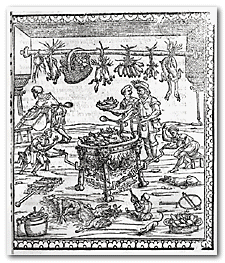Main Menu · Search · Current Issue · Contact · Archives · Centennial · Letters to the Editor · FAQs
![]()
Main Menu ·
Search · Current Issue · Contact · Archives · Centennial · Letters to the Editor · FAQs

| Gone Fission | High Flying |
| Harvard Men as Alcoholics | Bacterial Revenge |
| The Fall of the House of Ashes? | Cuisine Before Forks |
| E-mail and Web Information | |
 |
| Detail of a 1549 Italian woodcut shows the interior of a kitchen with a large decorated brazier in the center. One scullion blows the flames while two turn spits and the chief cook attends to the viands on top. Another cook rolls out pastry. |
In her Radcliffe course-as in her 1983 book, Savoring the Past: The French Kitchen and Table from 1300 to 1789-Wheaton shows how techniques, ingredients, workspaces, language, and the organization of books reveal much about gender, class, customs, and race. Before 1300, "there really weren't very many recipe collections-I can't even say cookbooks," she says. Thus, culinary historians "consider everyday stuff, not usually found in museums. We compare materials and shapes of utensils, or physical properties of tools like the quern-a primitive handmill that's basically two rocks."
Medieval French cooking centered around the fireplace. The cook boiled everything in a big iron caldron, the chaudière (hence "chowder"), that hung from a crémaillère (pothook). Other foods were cooked in the ashes-oeufs perdus, for example, involved cracking eggs and dropping them into embers, then brushing them off to be eaten. Wheaton relates the legend of Saint Lawrence, martyred by being roasted on a grill, "which, by one of those strange turns of the medieval imagination, led him to be made the patron saint of cooks."
French cooks of yore placed meats and dabs of sauce on whole wheat bread trenchers baked several days beforehand, then sliced these into rectangles; depending on rank, diners got three or four slices. Liquid foods went into the ècuelle, a shallow bowl shared by two people. One common main dish consisted of various meats tumbled together on a platter; this form of presentation, Wheaton notes, was "later called service en confusion..." Another presentation: carving the lids off venison (and other meat) pies so that diners could reach in and rummage with knives, spoons, or hands. Forks, alas, were rare.
"In medieval times, gluttony was taken very seriously. It was a sin to eat before the proper hour, or to enjoy food too much. When you consider the unreliability of supplies, and what eating more than your share might mean," says Wheaton, trailing off.
Difficulties of supply and storage influenced medieval meals, as did seasonal fluctuations in the availability of ingredients. Livestock couldn't be fed through the winter, so cooks salted their beef, rendered fat in glazed earthenware crocks, and hung hams and tongues to smoke in kitchen chimneys after dousing them in baths of spices and brine. Sugar was expensive, but boiled honey could preserve fruits, nuts, and root vegetables.
The Christian calendar also imposed limits. Abstinence meant no terrestrial animal products-fish were an exception. "Imitations were a feature of medieval cooking," says Wheaton, "and it pleased both cook and diner to pretend to break the fast-with 'eggs' fabricated from fish roe or curdled almond milk, or with the grandest hoax: 'bacon' slices or a 'ham' made with salmon for the pink meat, and pike for the fat." Diners esteemed the salted flesh of whale, dolphin, and porpoise (considered to be fish) as a Lenten delicacy. "With peculiarly medieval logic, the beaver's tail and the barnacle goose were also exempt from the Lenten meat taboo," Wheaton says. "It was believed that the beaver's tail never left the water and that the barnacle goose lived its entire life at sea, so both qualified as fish."
Some early ingredients are now unavailable, or undesirable: quail tongues, peafowl, swan, lamprey, blackbirds. ("Four and twenty blackbirds baked in a pie would serve about six," Wheaton says.) She lists herbs valued in the Middle Ages but now little used: tansy, rue, pennyroyal, hyssop. "In the use of spices-and of sharp-flavored fruits mixed with hashed-up meats-medieval dishes might be compared to some aspects of Indian and near Eastern cookery," she says.
Some early meals demanded elaborate preparation. Imagine, for example, a roast suckling pig served with a chicken (also roasted) riding on its back, wearing a paper helmet covered with silver leaf and carrying a silvered paper lance. Wheaton herself has actually roasted a peacock, then sewn it back into its skin, complete with feathers. This dish would shock a modern diner, she writes, "for there are so many steps between living creatures and dining that we are not prepared for so vivid a reminder that our meat is slaughtered."
In the fourteenth and fifteenth centuries the character or quality of dishes mattered less than abundance and expense. After entering to a trumpet fanfare, guests took part in a ceremony in which pages poured herb-scented water over their proffered hands. No one of rank ate anything before it was tested for poison. Aristocrats tested foods with substances allegedly possessing magical sensitivities-like unicorn horn (actually from narwhals), which was thought to bleed in the presence of impurity.
So, what's on Wheaton's own table lately? A food history of nineteenth-century France, to write. And to ingest? "In our household," she beams, "we eat too much of the right stuff."
Katrina Roberts
Main Menu ·
Search · Current Issue · Contact · Archives · Centennial · Letters to the Editor · FAQs
![]()
Harvard Magazine · 7 Ware Street · Cambridge, MA 02138 · Phone (617) 495-5746